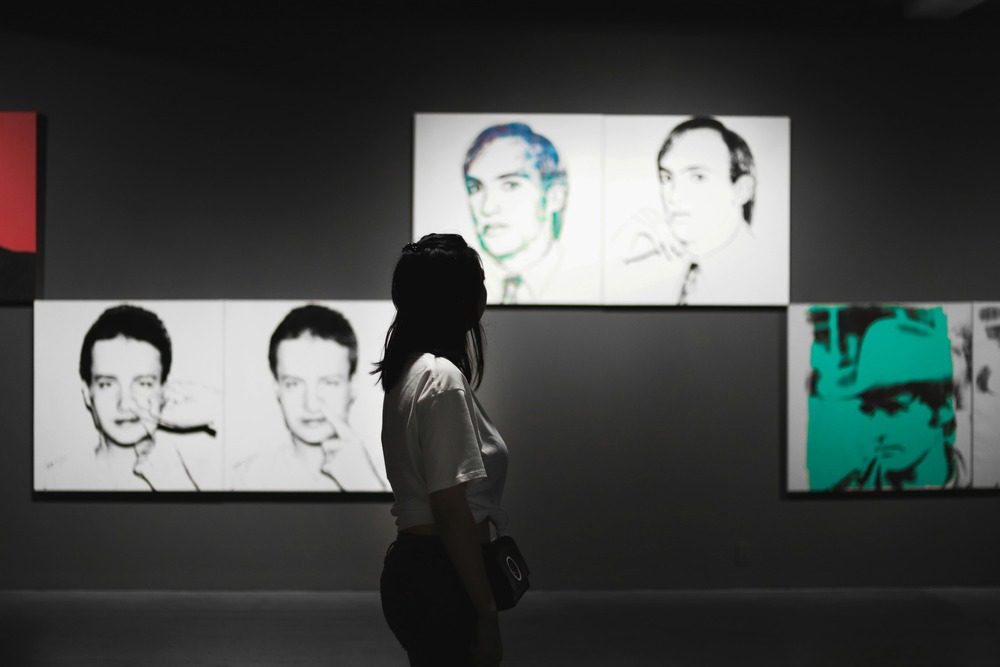Banner image by Mingjun Liu, sourced on Unsplash.
Andy Warhol’s artworks are often engaged with the idea of repetition — his silkscreen prints of Marilyn Monroe, Campbell’s soup cans, and electric chairs are prime examples of how he mechanized imagery, reflecting the post-1945 era of mass production as an artistic statement.
But what about Warhol’s Banana artwork? Unlike his repeating silkscreens, this singular image, famously featured on the cover of The Velvet Underground & Nico (1967), offers a different perspective on Warhol’s fascination with cycles of creation and decay. Though it does not repeat in the traditional sense, the banana’s potential for rot mirrors the themes of deterioration and mortality that haunt much of his work.
Read on to explore how Warhol used repetition to expose the fragile, fleeting nature of beauty, fame, and even life itself.
Who Was Andy Warhol?
Andy Warhol (1928–1987) was a pioneering artist and cultural icon who played a central role in the Pop Art movement of the 1960s. Originally trained as a commercial illustrator, Warhol gained fame for his ability to merge fine art with the visual language of advertising and mass media. His works often explored themes of consumerism, celebrity culture, and the mechanical reproduction of images, challenging traditional notions of artistic originality.
Beyond painting, Warhol was a prolific filmmaker, publisher, and founder of The Factory, his New York City studio that became a hub for artists, musicians, and avant-garde creatives. His fascination with fame and media extended beyond his artwork, shaping his persona as a celebrity in his own right. Warhol’s work remains influential, continuing to inspire discussions on art, commerce, and culture.
Why Did Warhol Emphasize Repetition in His Paintings?
Warhol’s signature use of repetition was more than a stylistic choice—it was a deliberate commentary on consumerism, media saturation, and the nature of modern identity. His Marilyn Monroe portraits, created after her death in 1962, repeat her face over and over with the intention of draining it of individuality.
In some versions, the colors are bright and alluring; in others, they fade into ghostly obscurity. The repetition becomes a kind of disintegration, an echo of Monroe’s public image being mechanically reproduced and ultimately dehumanized by mass media.
Similarly, Warhol’s Disaster series—a collection of works featuring repeated images of car crashes, suicides, and electric chairs—further amplifies this idea. By silkscreening horrific images over and over again, Warhol forces the viewer to confront the paradox of modern life: repetition both numbs us to violence and reinforces its omnipresence.
“Art historians have drawn on both Freudian psychology and contemporary media theory to understand how Warhol’s repetition of images reflect their presence in mass media and contribute to a system that desensitizes viewers,” says Tom Snow, Faculty, MA Contemporary Art at Sotheby’s Institute of Art. A single image of a car crash is shocking, but when repeated across a canvas, it becomes part of a larger, impersonal system.
Warhol and The Velvet Underground: The Banana Album Cover
Warhol’s Banana is perhaps most famous for its role as the cover artwork for The Velvet Underground & Nico (1967), an album he produced and championed. The artwork featured a simple yellow banana with an invitation that read: "Peel slowly and see." Early copies of the album allowed listeners to physically peel away the banana’s skin, revealing a pink, fleshy interior underneath—an interactive element that emphasized themes of desire, transformation, and exposure.
The Velvet Underground, an experimental rock band led by Lou Reed, was heavily associated with Warhol’s avant-garde circle, including his studio, The Factory. Warhol not only managed the band but also integrated them into his multimedia Exploding Plastic Inevitable performances, which combined music, film projections, and live art. The album itself was provocative, much like Warhol’s own art, exploring themes of addiction, sex, and the underbelly of urban life.
The Banana cover became an enduring symbol of Warhol’s ability to merge art with music and commerce, reinforcing his fascination with mass production while also playing with notions of impermanence. Just as the banana would rot in real life, the peelable cover deteriorated over time, making pristine copies highly sought after by collectors today.
Warhol’s Banana: The Illusion of Permanence
At first glance, Banana pictures a lone fruit, stripped of the pop repetition Warhol is known for. However, the fruit’s surface suggests something deeper: the possibility of rot. Unlike Warhol’s soup cans—symbols of mass production designed to last indefinitely—the banana is organic, perishable. The way Warhol rendered it, with its slightly darkened edges, hints at the passage of time, the inevitable transformation from fresh to spoiled.
“Warhol’s simplified screenprints mean that they could be reproduced quickly, relatively cheaply, and in large quantities, so to that extent they had greater affinity with photography than traditional painting,” says Snow. “Like any photographic snapshot, the iconic image is shown to be a superficial representation, depicted out of time, or frozen at a brief moment in time.”
If Monroe’s face in his silkscreens represents the fragility of fame, and his Disaster series exposes the fleeting nature of life itself, then Banana plays with the same idea in a subtler way. It is a reminder that even the most iconic, perfect, and recognizable objects (or people) are not immune to decay.
The Loop of Life and Death
Warhol’s Banana, when viewed in the context of his larger body of work, takes on an eerie new meaning. Like his repeated Marilyns and his looping disasters, it suggests that everything—whether a starlet, a moment of horror, or a simple piece of fruit—is locked in an endless cycle of being consumed, discarded, and forgotten. Warhol’s genius was in recognizing that this cycle, repeated enough times, ceases to shock us. And that, perhaps, is the real tragedy.
Advance your career with a certificate or degree in Contemporary Art. Learn more about our online courses and our Master’s Program in London.
